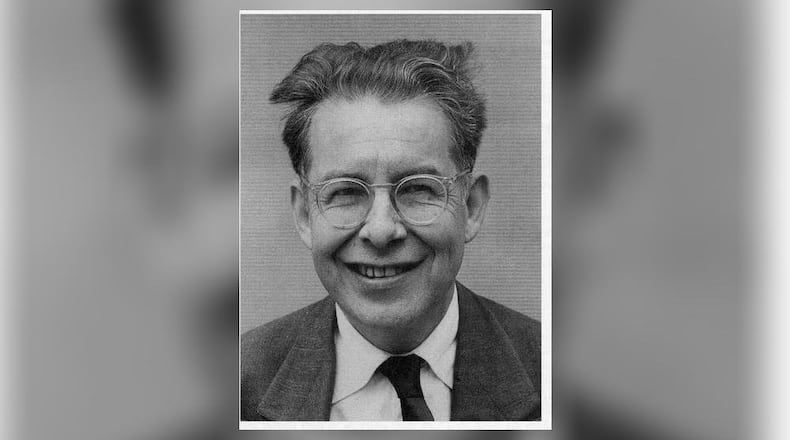The Richter Scale went into use in the 1930s to measure and compare the intensity of earthquakes. He developed the tool after getting a job at the Seismological Laboratory at Caltech, where he assigned himself the task of developing an objective way of comparing different earthquakes.
His work — and his Butler County heritage — brought him to the attention of county history buffs who began an annual observance of Richter Day on his birthday, April 26. Richter came to the attention of county historians through the book “Richter’s Scale: Measure of an Earthquake, Measure of a Man” by Susan Elizabeth Hough, published in 2007. That led to the founding of the Friends of Charles F. Richter Society and then the Richter Day observance, first held in 2011.
Organizers had planned to slightly change the focus of the observance beginning this year, changing the name to Earthquake Day.
The celebration was held virtually the past two years, due to the pandemic restrictions, and they had planned to do so again this year, but announced last week the there would be no formal program this year.
One of the society’s co-founders, Anne Jantzen, also known for her support for the Friends of Chrisholm, said they still encourage individual remembrance of Charles Richter.
“We invite local residents to bring a rock, decorated or plain, to place at the Richter Ohio Historical Marker at the Richter Roundabout on Richter’s birthday, April 26, as a tribute to this great scientist who was born on Wehr Road in Butler County, Ohio,” she said. “In addition, we encourage students, teachers and learners of all ages on that day, or anytime in the month of April, to delve into the study of earthquakes and find out about the scientist who developed the Richter Scale. An easy way to access this information is by going to the website, or by viewing the video Remarkable Richter on YouTube. Both of these sources were produced by Friends of Chrisholm Historic Farmstead with a grant from the W.E. Smith Family Charitable Trust.”
Using as many earthquake references as she could muster, Jantzen gave a brief summary of the name change for the observance.
Jantzen said it is appropriate the observance is held in April because it is recognized as Autism Awareness Month. Richter’s life was difficult because he wasn’t “normal” in the eyes of society and had difficulty making friends. it was due to him having Asperger’s Syndrome, a mild form of high-functioning autism for which symptoms include difficulty with social interaction and sensory reception.
“He is a good example of someone who had to struggle, yet he made significant contributions to science,” Jantzen said. “He was homeschooled and had a nervous breakdown in high school in California. In college, he started studying chemistry but was nervous and broke a lot of beakers, so it was suggested he go into a different field.”
He had started college at the University of Southern California but transferred to Stanford to major in chemistry, but after being asked to switch majors, he went into physics and graduated at the age of 20.
The stress resulted in a major bout of depression which required hospitalization. After that, however, he moved into graduate work in physics and seemed likely to do research in that area and become a professor. By a “happy accident,” however, he landed the job at the Seismological Laboratory at Caltech and began his research.
In a short biography of Richter in 2012, Jantzen described that work: “This involved studying massive amounts of data in the day before personal computers. But Richter persisted and, ‘My calculations worked out much better than I had expected and produced this definitive numerical scale that practically fell out of the data.’ The Richter Scale was born!”
Richter (1900-1985) was born in St. Clair Twp. and spent his early years on his mother’s family farm. His parents — Lillian and Frederick Kinsinger — had a daughter, Margaret, and then divorced. They remarried eight years later, and Charles was born but they later divorced a second time. Kinsinger remarried but Lillian changed her name back to her family name, Richter, and Charles later changed his name to Richter, as well.
They lived with her parents on their family’s farm on Wehr Road near Overpeck until he was about 10 and his grandfather moved the family out to California.
Richter’s early years in Butler County are commemorated with a history marker and, thanks to students from Edgewood High School, a roundabout near the school has been officially named the “Richter Roundabout” despite hesitancy by the county and state.
Jantzen explained the students had made the suggestion and were told no other roundabout had been given a name. The students persisted and it became the first.
In past years, participants have been asked to bring a rock with a message on it and to wear a shoestring in place of a tie.
Miami University Professor Mike Brudzinski, speaking in a video on the charlesrichter.org website, explained Richter was once so wrapped up in his research, his secretary reminded him of a meeting at which he was to make a presentation. She suggested he wear a tie and he did not have one with him and substituted for it by using one of his shoelaces.
He reportedly turned to her and asked, “Will this do?”
It’s all a bit of fun, but has the serious intent of raising interest in a scientist who contributed to knowledge of earthquakes and began life here in Butler County.
About the Author
